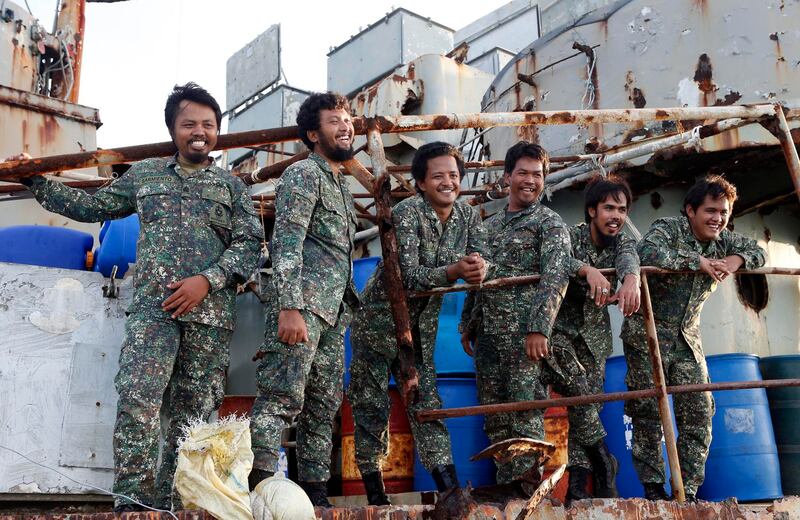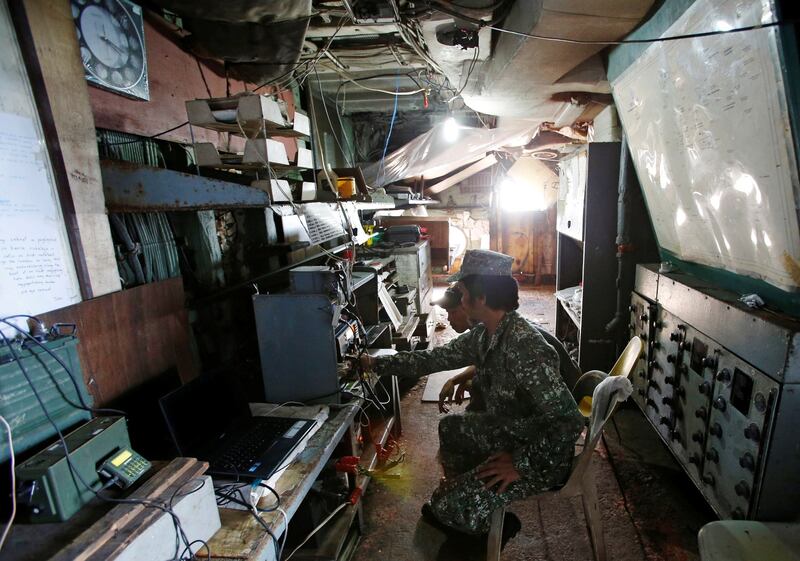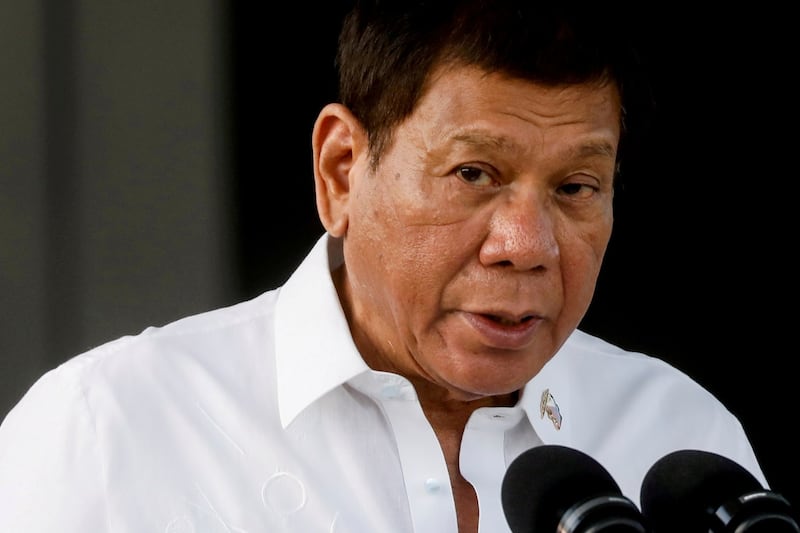Recent developments have brought to the world’s attention an unlikely symbol of Philippine sovereignty in the South China Sea – a dilapidated naval ship from World War II – as China cranks up pressure and Manila struggles to sustain its foothold there.
The BRP Sierra Madre ran aground on the Second Thomas Shoal, or Ayungin Shoal as it is called in the Philippines, in 1999. It serves as a Philippine military outpost in the disputed waters. After 22 years, all that remains is a skeleton of rusty scrap metal.
The Philippine government insists that the shoal is part of the continental shelf over which the Philippines has sovereign rights and jurisdiction, but China says it is "part of China's Nansha Qundao (Spratly Islands)" and demands " that the Philippine side honor its commitment and remove its illegally grounded vessel."
The shoal is what is known as a low-tide elevation – meaning it is a naturally formed area of land which is above water and surrounded by water at low tide but submerged at high tide. It lies 105 nautical miles west of the Philippine island province of Palawan – well within the Philppines' 200 nautical-mile exclusive economic zone (EEZ).
Tensions over the shoal have escalated since Nov. 16 when Chinese coast guard ships blocked and fired water cannons on two Philippine boats to prevent them from delivering supplies to the team of marines stationed on the Sierra Madre.
That drew strong protests from Manila and its ally the United States, which threatened that the incident would trigger the U.S.-Philippines 1951 Mutual Defense Treaty. A week later, the resupply mission was completed as China looked on from nearby.
But uncertainty remains about the future of the Sierra Madre and whether the Philippines can maintain its presence at the Second Thomas Shoal for long.

‘Humanitarian considerations’
The 100 metre-long BRP Sierra Madre, originally the USS LST-821, then the USS Harnett County, was a tank-landing ship built for the U.S. Navy during World War II. It also served in the Vietnam War and was transferred to the Philippines in 1976 and renamed for a third time.
It was believed to be en route to the Scarborough Shoal, another feature located within the Philippines’ EEZ, when it struck an underwater reef and ran aground in May 1999.
Some say it was an accident but Manila claims the ship “was placed to serve as a permanent Philippine government installation in response to China’s illegal occupation of Mischief Reef in 1995.” Mischief Reef is another Spratly Islands feature inside the Philippine EEZ.
Beijing, however, asserted that Philippine officials promised to take the ship away and has many times demanded that the Sierra Madre be removed. China has also said that the “delivery of food and other supplies is a provisional, special arrangement out of humanitarian considerations” for the eight or so Philippine marines on site.
The first time the Chinese coast guard intervened to stop the vessels doing regular resupply and personnel rotation for Philippine troops at the shoal was in March 2014 as it suspected that they were carrying construction materials.
"This is because the Sierra Madre is falling apart and the armed forces want to fortify the ship. It's very much in China's interest to see the vessel collapse so the marines would have to withdraw and China could move in,” explained Ian Storey, senior fellow at the ISEAS-Yusof Ishak Institute in Singapore.
“Another option for China would be to blockade the shoal and starve the marines into surrender,” Storey said.
While most observers agree that the Philippines will not concede to China’s demand to remove the Sierra Madre, this is a war that Manila is finding very hard to win.
“The Chinese can block resupply of the Sierra Madre at any time, and they can choose how much to escalate the conflict and if and when they should de-escalate it,” said Zachary Abuza, professor at National War College in Washington, D.C.
“The Philippines has no resources - fiscal or otherwise - to reclaim the territory. And China would never allow wholesale reclamation work to begin,” Abuza said.
“As such, the best the Philippines can do is hope that the BRP Sierra Madre doesn't rust and disintegrate any faster than it already is. The poor Philippine marines are living on a death trap, and I sincerely hope that they are up to date on their tetanus shots,” he added.

America’s dilemma
One possible worst-case scenario, according to Abuza, is that in a monsoon, China comes to "rescue" the Philippine marines for humanitarian purposes.
“That would be a ‘non-kinetic’ way to remove the Philippines from the Second Thomas Shoal, and one that would provoke little in the way of an international backlash,” he said.
“Or the Chinese Navy could simply tow the Sierra Madre off the reef, something that the Philippine Navy would find difficult to prevent unless the government invoked the Mutual Defense Treaty with America,” said Storey.
In that case, the United States would be faced with a very difficult dilemma.
“I think a Chinese attempt to seize the Second Thomas Shoal would certainly generate some sort of U.S. response,” said Malcolm Davis, a senior analyst at the Australian Strategic Policy Institute.
“If the U.S. didn't act under those circumstances, it would undermine its credibility not only in the eyes of the Philippines, but also encourage concerns that the U.S. won't support allies, a concern that has grown since Afghanistan,” he said, referencing the abrupt U.S. withdrawal from the Central Asian nation earlier this year.
“So my guess is the U.S. would deploy naval forces to prevent such an attack, and raise the potential cost to Beijing of acting, but the question would be how Beijing challenged that response,” Davis added.
The Australian analyst argued that “it’s also important to note that there's a Taiwan dimension to this, and if the U.S. fails to act in support of the Philippines, then that could encourage Beijing to be more aggressive against Taiwan, bringing on a much more serious crisis sooner.”
In recent months, China has been increasing pressure on democratic Taiwan, another potential flashpoint for superpower conflict. Beijing claims the self-governing island is part of China, although Taiwan regards itself as a sovereign state.

'Sea of peace, stability and prosperity'
The Second Thomas Shoal is claimed by China, the Philippines, Taiwan and Vietnam but at present, tensions have largely remained between Manila and Beijing.
At the weekend, in a speech during the virtual 13th Asia-Europe (ASEM) Summit Philippine President Rodrigo Duterte said "real peace cannot be achieved if the strong continues to trample the weak."
“The South China Sea must remain a sea of peace, stability and prosperity, where the vital interests of stakeholders inside and outside the region are recognized and respected,” Duterte said, calling on all countries “to adhere to the rule of law,” especially the 1982 United Nations Convention on the Law of the Sea.
It was during the Duterte’s administration that the Philippines carried out a rapprochement policy towards China and “the two sides worked with each other to restrain their disputes in the South China Sea,” said Zhang Baohui, professor of political science at Lingnan University in Hong Kong.
While admitting that he is “quite surprised to see this issue (the Second Thomas Shoal incident) resurfacing once again between China and the Philippines,” Zhang said it is mainly because of next year’s presidential election in the Southeast Asian nation “it is impossible for anyone in the race to look soft on this.”
There have been talks in Manila about how to reinforce and defend the BRP Sierra Madre. Some have suggested building a structure around to support it, the way Vietnam fortifies its remote South China Sea outposts.
Last Friday Sen. Panfilo Lacson, head of the Philippine Senate national defense and security committee, filed a resolution in which he proposed refurbishing the ship and deploying another one to the shoal.
Lacson also urged the government to “fortify, amplify and enhance our positions in the West Philippine Sea through defense and security agreements with other nations.”
However, according to Zhang, a solution may have to wait until after the election.
“If the next administration tries to model its China policy after that of Duterte, then the two sides may be able to reach a compromise. If however, the next president leans toward a hard-line policy toward China, he or she may seek to restore security cooperation with the U.S. to boost the (Philippine) position in the South China Sea,” Zhang said.
“That would certainly lead to heightened conflict with China over the Second Thomas Shoal and the Scarborough Shoal,” he predicted.
